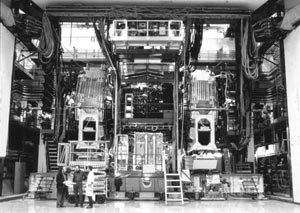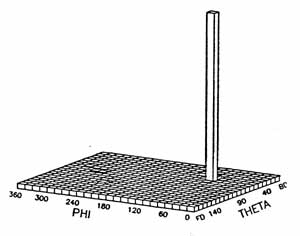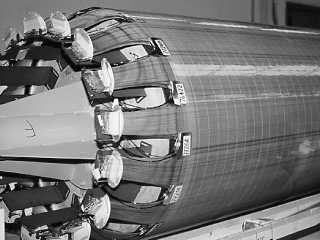High Energy Physics Group History - UA2
The UA2 detector
Richard Ansorge, Bob DeWolf, Sven Katvars, Michel Lefebvre, David Munday, Andy Parker, Mike Pentney, John Rushbrooke, Simon Singh, Wai Tsang, Pippa Wells, Tom White, Steve Wotton

The Electroweak Standard Model of particle physics, developed by Glashow, Salam and Weinberg, unified the electromagnetic and weak nuclear forces into a single theory and predicted the existence of the previously unknown W and Z bosons. Together with the more familiar photon, these particles explain the electroweak interactions of fundamental particles. Furthermore, using existing measurements, the theory predicted the masses of the W and Z bosons. Armed with this knowledge, experiments were devised to detect and measure the properties of these new particles.
Soon after the new SppS proton-antiproton collider at CERN was switched on in 1981 the UA2 experiment co-discovered the W and Z bosons with the UA1 experiment in spectacular confirmation of the new theory. The W and Z bosons decay very quickly after they are produced but the decays leave characteristic energy deposits in the detectors. An example of the energy distribution due to a W boson decaying into an electron and a neutrino and recorded in the UA2 detector can be seen on the right. The electron is stopped in the detector and deposits all of its energy in a small region. The neutrino is not detected and escapes.
Key UA2 electroweak measurements include:
- W boson mass, mW=80.84±0.22±0.17±0.81GeV/c2;
- Z boson mass, mZ=91.74±0.28±0.12±0.92GeV/c2;
- W boson width, ΓW=2.10±0.14±0.08GeV/c2;
- sin2θW=0.2234±0.0072.
In addition to the properties of the W and Z bosons, the UA2 experiment made many important measurements in the fields of QCD and searches for new particles including measurements of:
- the strong coupling constant, αs(MW2)=0.123±0.018±0.017;
- measurements of jet cross-sections and angular distributions;
- direct photon production;
- the top quark mass, mt=160±60GeV/c2 (for mH=100GeV/c2).
[1 GeV/c2 is roughly equal to the mass of 1 proton]
Electron identification was one of the great strengths of UA2 and was the focus of the Cambridge group's participation in the experiment. We joined UA2 at the beginning of an upgrade programme that allowed the more precise measurements of the W and Z mass and widths to be made.
We collaborated in the design, installation and operation of a new scintillating fibre detector (SFD) that improved the UA2 tracking and electron identification performance. The detector was a combination of several novel technologies: scintillating fibres as the active element; custom image intensifiers with integrated CCD readout to collect the signals; and custom digitiser modules designed and built in the Cambridge HEP group to process the CCD images.
Light produced by the passage of charged particles as they pass through a fibre travels along to the end where it is collected and amplified by the image intensifiers. Many individual fibres are grouped into a bundle and imaged together by a single image intensifier and CCD. By associating the detected light with the correct fibre it is possible to reconstruct which fibres were hit by a particle and then to deduce the position and direction of the particle track in 3-D. The SFD also incorporated a layer of lead that allowed to localise the energy deposited by photons more precisely than was possible using calorimetry alone.
Later, the Cambridge group worked on the development of a new silicon pad detector for a subsequent upgrade of the experiment. Silicon detector development has continued to be an important area of expertise within the group; expertise that has been applied both in the OPAL experiment at LEP and the ATLAS experiment at the LHC.


